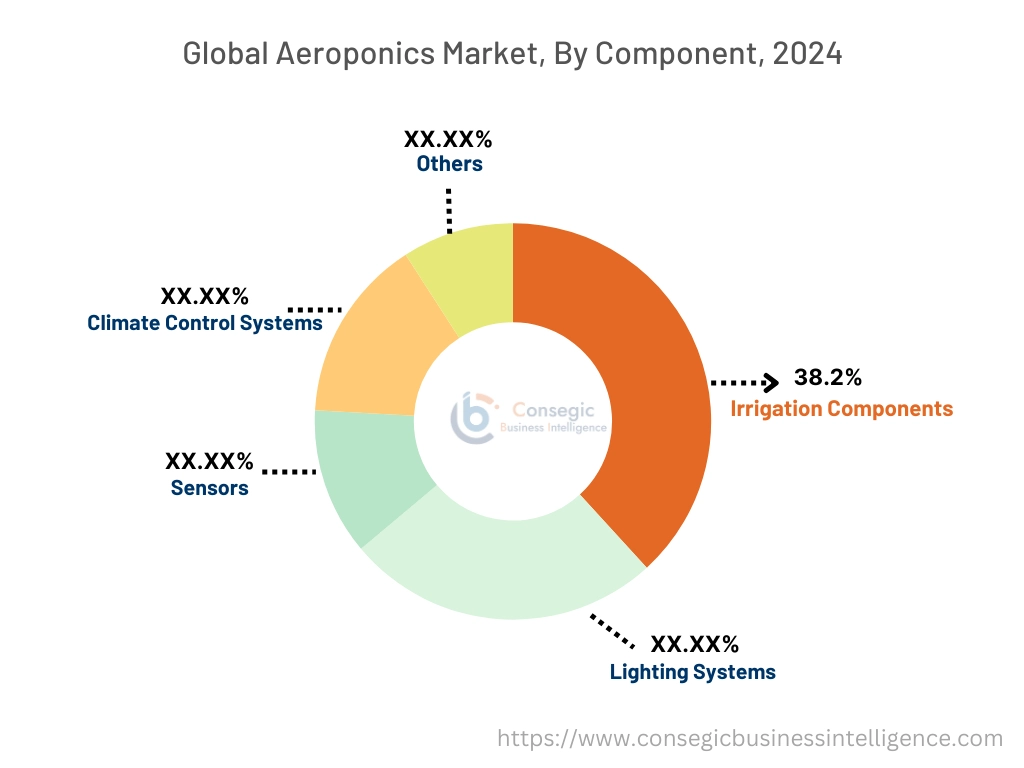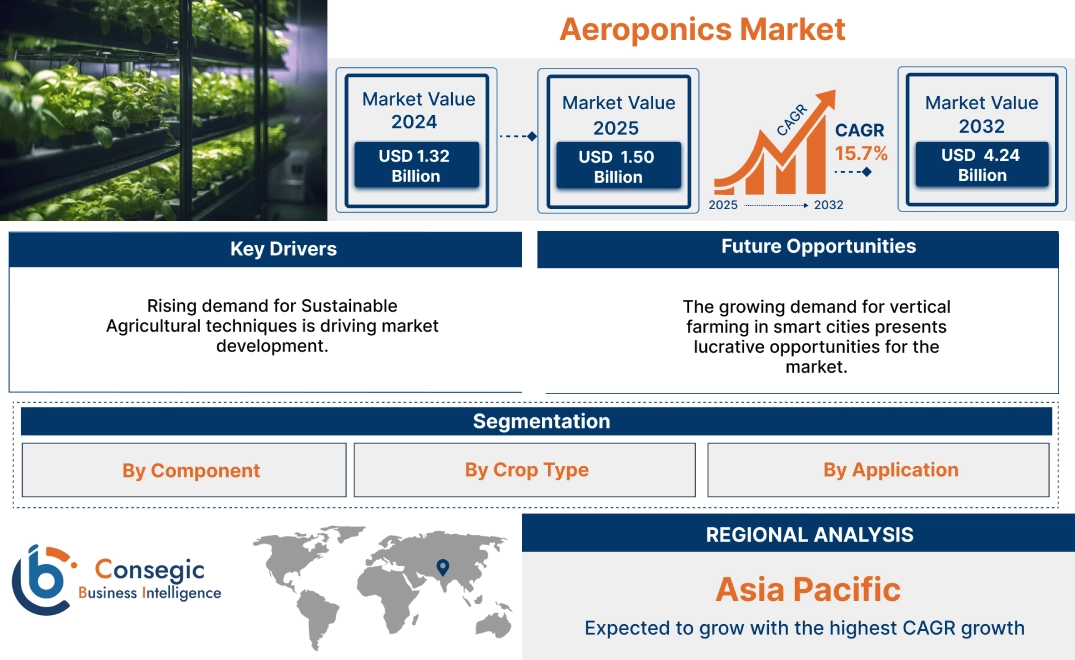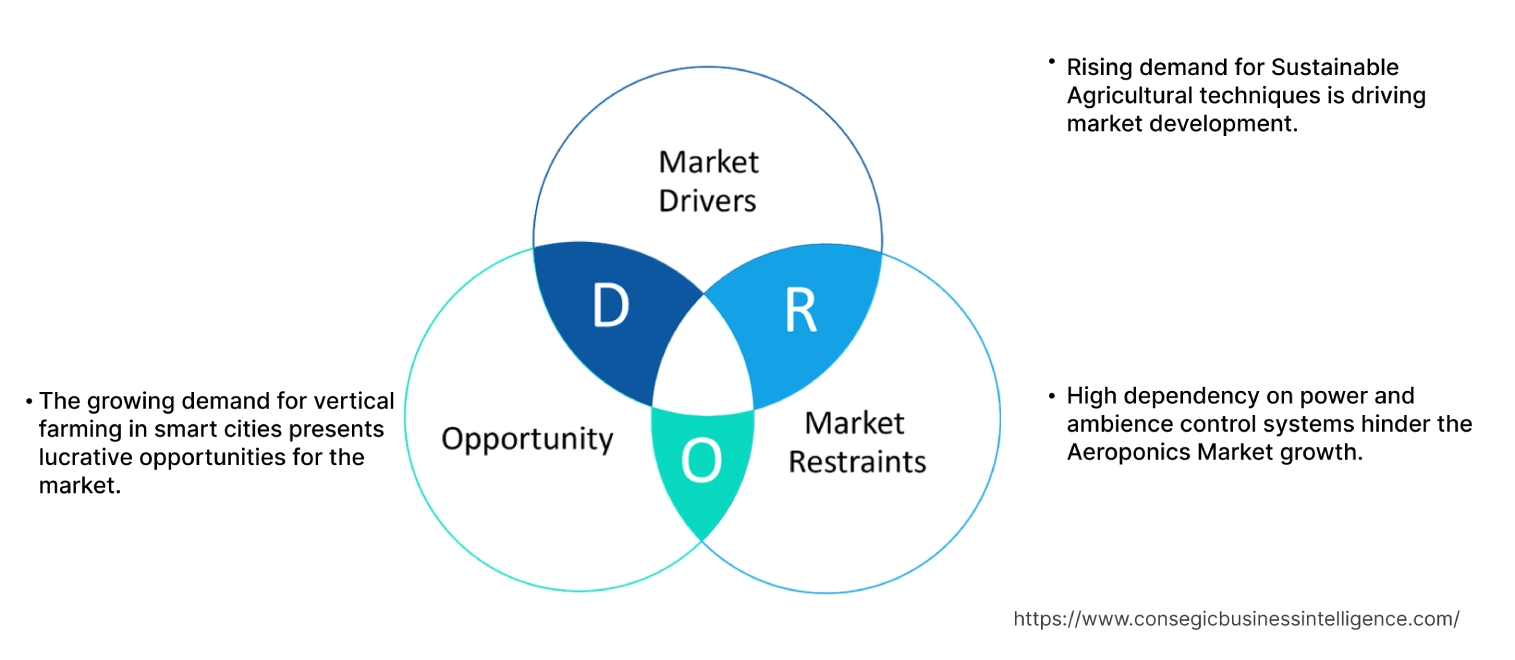- Summary
- Table Of Content
- Methodology
Aeroponics Market Size:
Aeroponics Market size is estimated to reach over USD 4.24 Billion by 2032 from a value of USD 1.32 Billion in 2024 and is projected to grow by USD 1.50 Billion in 2025, growing at a CAGR of 15.7% from 2025 to 2032.
Aeroponics Market Scope & Overview:
Aeroponics, also known as mist cultivation, is a soil-free farming method that involves delivering nutrients to plant roots in the form of a fine mist inside a closed or semi-closed chamber. The technique is engineered to maximize root oxygenation while providing precise control over nutrient concentration, humidity, and pH levels. It is particularly suited to controlled-environment agriculture, where space, water, and resource efficiency are critical.
The system structure typically includes high-pressure nozzles for mist, enclosed root chambers, nutrient reservoirs, and real-time environmental sensors. These components work in coordination to ensure that roots are suspended in air while receiving periodic sprays of nutrient-enriched water. Unlike hydroponic systems, aeroponic platforms do not rely on a continuous water flow, reducing the risk of root zone saturation and pathogen buildup.
Aeroponics assist dense planting configurations and helps in rapid phenotype screening, aiding space optimization, consistency and growth. End-users include vertical farming operators, plant research institutions, and advanced nursery propagation units that require precision growing conditions.
Key Drivers:
Rising demand for Sustainable Agricultural techniques is driving market development
Traditional soil-based farming often leads to excessive water consumption, soil degradation, and overuse of chemical fertilizers and pesticides, which harm the environment. Aeroponics offers a more sustainable solution, especially in urban farming and arid regions where water resources are limited. By using a mist or aerosol to deliver nutrients to plant roots, it reduces water usage by up to 90% compared to conventional soil-based agriculture. Additionally, it eliminates the need for soil, reducing land degradation and the need for harmful chemical inputs.
- For instance, in March 2025, LettUs Grow and KG Systems announced a global strategic partnership to commercialize their cutting-edge Advanced Aeroponic Technology across the globe. This partnership aims to transform sustainable agriculture by using ultrasound to enhance growth in plants.
Furthermore, the worldwide emphasis on sustainability and resource efficient agriculture practices making it a key technology proofing future global food production is significantly driving the aeroponics market demand.
Key Restraints:
High dependency on power and ambience control systems hinder the Aeroponics Market growth
The system used for aeroponics rely largely on electricity to run essential components such as pumps, lighting, and climate control systems. These systems are designed to maintain optimal growing conditions, such as precise humidity, temperature, and nutrient delivery. However, in regions where electricity is not stable, it presents a significant barrier as power outages and electricity fluctuations can disrupt the entire growing process, potentially damaging crops and reducing yield. Additionally, these systems require consistent climate control, which is difficult to achieve in areas with extreme weather conditions, such as high temperatures or intense humidity. Maintaining a farm in such unreliable power and climate conditions hugely hinder the process. Therefore, such barriers limit the widespread adoption of the system, impeding the overall global Aeroponics Market demand.
Future Opportunities :
The growing demand for vertical farming in smart cities presents lucrative opportunities for the market
Urban areas are emerging as an innovative option for vertical farming solutions, helping optimize land use while reducing transportation costs and environmental impact. Vertical farming enables farmers to grow crops in stacked layers, utilizing mist cultivation technology to minimize water usage and maximize productivity. Additionally, by eliminating the need for large, expansive land areas, vertical farming integrated with this technology will offer an environmental friendly way to grow fresh produce in urban environments, where traditional farming methods are impractical. This will help in reducing transportation costs and minimize food wastage.
- For instance, in February 2023, AeroFarms revealed AeroFarms AgX, a high-throughput indoor vertical farm to carry out research and development (R&D) activities in the UAE and the Middle East. This farm will ensure sustainable CEA and indoor vertical farming to address global agriculture challenges.
Furthermore, these technologies will allow farmers to make informed decisions, aid in offering efficient management of space and resources, and reduce carbon footprints, thereby fueling the global aeroponics market opportunities.
Aeroponics Market Segmental Analysis :
By Component:
Based on Component, the market is categorized into irrigation components, lighting systems, sensors, climate control systems, and others.
The Irrigation Components segment holds the largest revenue of the overall Aeroponics Market share of 38.2% in the year 2024.
- Irrigation components are the most fundamental part of mist cultivation systems and include high-pressure pumps, micron nozzles, tubing lines, and nutrient reservoirs that atomize and deliver water-soluble nutrients to plant roots.
- These components are crucial for maintaining consistent plant health, oxygenation, and nutrient uptake, making them the most critical and expensive component.
- Additionally, these components are constantly in operation and prone to wear, prompting recurring demand for replacements, upgrades, and preventive maintenance across all commercial installations.
- For instance, in April 2024, LettUs Grow partnered with Innovative Growers Equipment (IGE), to introduce ultrasonic aeroponics to producers using greenhouses in the US and Canada. This partnership will allow IGE to manufacture LettUs Grow’s patented ultrasonic irrigation systems.
- According to the Aeroponics Market analysis, the significance of irrigation systems and their high frequency of replacement drive their increased requirement, significantly fueling the Aeroponics Market expansion.
The Climate Control Systems segment is expected to grow at the fastest CAGR during the forecast period.
- Climate control systems include HVAC units, dehumidifiers, air circulation fans, CO₂ enrichment modules, and temperature/humidity control panels, essential for stabilizing environmental conditions in closed aeroponic systems.
- The shifting trend towards fully automated mist cultivation has accelerated the adoption of IoT-enabled climate systems with AI-driven feedback loops that adjust airflow, humidity, and temperature based on plant stage and density.
- Additionally, with the expansion of vertical farms and urban container farms, precise management of climate has become crucial to ensure consistent crop cycles, preventing contaminations, and optimizing transpiration.
- As per the market analysis, growing number energy-efficient technologies and rising trend for smart climate control devices, the global Aeroponics Market is expanding.

By Crop Type:
Based on Crop Type, the market is categorized into fruits, leafy vegetables, herbs and microgreens, and others.
The leafy vegetables segment holds the largest revenue of the overall Aeroponics Market share in the year 2024.
- Vegetables, particularly leafy greens like lettuce, spinach, kale, and arugula, are ideally suited for mist cultivation due to their shallow root systems and fast growth cycles.
- These crops show significant productivity gains when grown in aeroponic systems, making them economically attractive for commercial growers.
- Additionally, short cultivation periods, and high market requirement for fresh-cut vegetables make the segment readily supported by retailers and foodservice providers seeking consistent, locally produced, and clean-label vegetable supply chains.
- According to the Aeroponics Market analysis, high demand for leafy vegetables across all regions make it the largest segment, significantly fueling the market growth.
The herbs and microgreens segment is expected to grow at the fastest CAGR during the forecast period.
- Culinary and medicinal herbs like basil, cilantro, mint, and oregano are gaining momentum in mist cultivation due to high returns per unit area and strong flavor retention under controlled conditions.
- The producers are targeting the premium markets like gourmet restaurants, nutraceuticals, and herbal supplements, which demand high level of consistency and pesticide free production.
- Additionally, these herbs are benefitted by precise nutrients and managed climate conditions in these setups that ensure continuous harvesting with consistent quality.
- As per the market trends, rising need of herbs for their medicinal purposes and their high export potential have substantially driven the global Aeroponics Market opportunities.
By Application:
Based on Application, the market is categorized into indoor farming and outdoor farming.
The indoor farming segment holds the largest revenue share of the overall Aeroponics Market in the year 2024 and is expected to grow at the fastest CAGR during the forecast period.
- Indoor farming is the largest application segment due to its compatibility with controlled environment agriculture (CEA), where factors like light, temperature, humidity, and CO₂ concentration can be precisely regulated.
- Vertical farming techniques often need indoor setup that require space efficiency and high-yield cycles.
- Additionally, this application is widely adopted in urban settings and food-insecure regions where traditional soil-based agriculture is not viable, enabling year-round crop production regardless of external weather conditions.
- For instance, in February 2023, GreenLife Company announced the launch of its new smart agriculture project in Kuwait. This indoor air farm utilizes aeroponics technology that will ensure sustainable and high-quality agricultural products in Kuwait.
- Thus, the market analysis shows that consistent pesticide free, year-round supply of crops grown through indoor farming, not only makes it the largest segment but also projected to grow at fastest CAGR throughout the forecast period, significantly driving the Aeroponics Market trends.
Regional Analysis:
The regions covered are North America, Europe, Asia Pacific, the Middle East and Africa, and Latin America.

Asia Pacific region was valued at USD 0.39 Billion in 2024. Moreover, it is projected to grow by USD 0.44 Billion in 2025 and reach over USD 1.29 Billion by 2032. Out of this, China accounted for the maximum revenue share of 32.2%.
In the Asia-Pacific region, the diversification of agricultural practices and changing climate is fueling the trend for mist cultivation. Another trends involves the integration of digital monitoring tools that allow farmers to remotely control and fine-tune their irrigation protocols. Additionally, the rising government initiatives to drive innovations and cutting-edge farming technologies further drives the market.
- For instance, in May 2024, LettUs Grow announced the partnership with Valoya India to optimize production of crops for indoor producers. Valoya India has licensed the LettUs Grow’s patented ultrasound irrigation technology to improve crop quality and minimize water use for vertical farming companies.
Furthermore, the regional analysis depicts that the growing technological advancements and collaborative efforts between regional technology developers and farming communities have significantly driven the Aeroponics Market growth.

North America is estimated to reach over USD 1.37 Billion by 2032 from a value of USD 0.44 Billion in 2024 and is projected to grow by USD 0.50 Billion in 2025.
In North America, the market is influenced by the rising trend in sustainable development and modern agriculture practices. Additionally, the integration of sensor-based systems with digital controls to optimize water and nutrient delivery in the mist cultivation setups are fueling the market development.
- For instance, in January 2025, AeroFarms announced that it has patented aeroponics technology that leverages a fully commercialized climate-agnostic, economically viable vertical farming solution. AeroFarms caters their microgreens to over 70% of the U.S. market with its strong flavors, versatility, and nutritional benefits of microgreens.
As per the regional analysis, the increasing collaboration and partnerships between technology developers and agricultural stakeholders and the adoption of innovative air- and mist-based propagation methods that enhance plant growth in controlled environments, have significantly driven the aeroponics industry in this region.
Europe holds a significant market share due to the strong focus on sustainable farming methods to increase crop efficiency. One notable trends is the gradual substitution of traditional soil-based methods with advanced aeroponic systems that deliver precise irrigation and nutrient management. Analysis of the market showed that strict regulatory frameworks and environmental considerations are instrumental in shaping technology deployment, further boosting the Aeroponics Market in this region.
The Aeroponics Market in the Middle East and Africa experiences increased requirement for these systems due to the overgrowing pressure to conserve water resources. The shifting trend towards robust, weather-resistant technologies that optimize nutrient delivery in challenging environments is fueling the market in this region. Furthermore, focused government policies and smart investments in infrastructure are key to adopting these systems and laying the groundwork for long-lasting, sustainable farming practices, significantly driving the industry growth.
In Latin America, the shifting trend towards incorporating mist cultivation systems for more efficient crop production and the development of versatile, user-friendly technologies accommodating diverse crop types and varying climatic conditions drives the market in this region. Market analysis shows that the growing initiatives to update farming methods with a focus on sustainability are significantly driving the market expansion.
Top Key Players and Market Share Insights:
The Aeroponics Market is highly competitive with major players providing products and services to the national and international markets. Key players are adopting several strategies in research and development (R&D), product innovation, and end-user launches to hold a strong position in the global Aeroponics Market. Key players in the Aeroponics industry include -
- LettUs Grow (United Kingdom)
- AeroFarms (United States)
- Altius Farms (United States)
- CleanGreens Solutions SA (Switzerland)
- Greenlife GCC (Kuwait)
- Denso Corporation (United States)
- Tower Garden (United States)
- True Garden (United States)
- Jain Irrigation Systems Ltd. (India)
- Green Warrior (India)
Recent Industry Developments :
Collaborations and Partnerships:
- In August 2023, Certhon and Living Greens Farm partnered to develop and expand Living Greens Farm’s aeroponics growing technology globally. This partnership aims to provide both the companys’ expertise to develop efficient, sustainable, and scalable vertical farming systems for leafy greens and salad crops.
Aeroponics Market Report Insights :
| Report Attributes | Report Details |
| Study Timeline | 2019-2032 |
| Market Size in 2032 | USD 4.24 Billion |
| CAGR (2025-2032) | 15.7% |
| By Component |
|
| By Crop Type |
|
| By Application |
|
| By Region |
|
| Key Players |
|
| North America | U.S. Canada Mexico |
| Europe | U.K. Germany France Spain Italy Russia Benelux Rest of Europe |
| APAC | China South Korea Japan India Australia ASEAN Rest of Asia-Pacific |
| Middle East and Africa | GCC Turkey South Africa Rest of MEA |
| LATAM | Brazil Argentina Chile Rest of LATAM |
| Report Coverage |
|
Key Questions Answered in the Report
How big is the Aeroponics Market? +
Aeroponics Market size is estimated to reach over USD 4.24 Billion by 2032 from a value of USD 1.32 Billion in 2024 and is projected to grow by USD 1.50 Billion in 2025, growing at a CAGR of 15.7% from 2025 to 2032.
What specific segments are covered in the Aeroponics Market? +
The Aeroponics Market specific segments for Component, Crop Type, Application, and Region.
Which is the fastest-growing region in the Aeroponics Market? +
Asia pacific is the fastest growing region in the Aeroponics Market.
What are the major players in the Aeroponics Market? +
The key players in the Aeroponics Market are LettUs Grow (United Kingdom), AeroFarms (United States), Altius Farms (United States), CleanGreens Solutions SA (Switzerland), Greenlife GCC (Kuwait), Denso Corporation (United States), Tower Garden (United States), True Garden (United States), Jain Irrigation Systems Ltd. (India), Green Warrior (India), and others.


